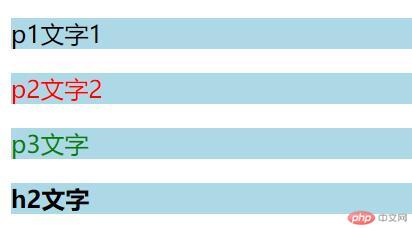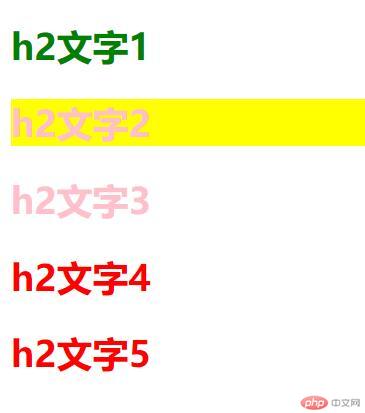批改状态:合格
老师批语:合理的使用css, 可以让你的html代码非常的简洁
| 序号 | 选择器 | 描述 | 举例 |
|---|---|---|---|
| 1 | 元素选择器 | 根据元素标签名称进行匹配 | div {...} |
| 2 | 群组选择器 | 同时选择多个不同类型的元素 | h1,h2,h3{...} |
| 3 | 通配选择器 | 选择全部元素,不区分类型 | * {...} |
| 4 | 属性选择器 | 根据元素属性进行匹配 | *[...] |
| 5 | 类选择器 | 根据元素 class 属性进行匹配 | *.active {...} |
| 6 | id 选择器 | 根据元素 id 属性进行匹配 | *#top {...} |
<title>简单选择器</title><style>/*元素选择器*/p {color: blue;}/*属性选择器*/p[class="p2"] {color: red;}/*类/class选择器*/.p3 {color: green;}/*ID选择器*/#p1 {color: black;}/*群组选择器*/p,h2 {background-color: lightblue;}/*通配符选择器*/* {font-size: 1rem;}</style></head><body><p class="p1" id="p1">p1文字1</p><p class="p2">p2文字2</p><p class="p3">p3文字</p><h2>h2文字</h2></body>

| 序号 | 角色 | 描述 |
|---|---|---|
| 1 | 祖先元素 | 拥有子元素,孙元素等所有层级的后代元素 |
| 2 | 父级元素 | 仅拥有子元素层级的元素 |
| 3 | 后代元素 | 与其它层级元素一起拥有共同祖先元素 |
| 4 | 子元素 | 与其它同级元素一起拥有共同父级元素 |
| 序号 | 选择器 | 操作符 | 描述 | 举例 |
|---|---|---|---|---|
| 1 | 后代选择器 | 空格 |
选择当前元素的所有后代元素 | div p, body * |
| 2 | 父子选择器 | > |
选择当前元素的所有子元素 | div > h2 |
| 3 | 同级相邻选择器 | + |
选择拥有共同父级且相邻的元素 | li.red + li |
| 4 | 同级所有选择器 | ~ |
选择拥有共同父级的后续所有元素 | li.red ~ li |
<title>上下文选择器</title><style>/*后代选择器*/section h2 {color: green;}/*父子选择器*/section > h2 {color: red;}/*同级相邻选择器*/#item + h2 {background-color: yellow;}/*同级所有选择器*/#item ~ h2 {color: pink;}</style></head><body><section><div><h2 id="item">h2文字1</h2><h2>h2文字2</h2><h2>h2文字3</h2></div><h2>h2文字4</h2><h2>h2文字5</h2></section></body>

| 序号 | 选择器 | 描述 | 举例 |
|---|---|---|---|
| 1 | :first-child |
匹配第一个子元素 | div :first-child |
| 2 | :last-child |
匹配最后一个子元素 | div :last-child |
| 3 | :only-child |
选择元素的唯一子元素 | div :only-child |
| 4 | :nth-child(n) |
匹配任意位置的子元素 | div :nth-child(n) |
| 5 | :nth-last-child(n) |
匹配倒数任意位置的子元素 | div :nth-last-child(n) |
| 序号 | 选择器 | 描述 | 举例 |
|---|---|---|---|
| 1 | :first-of-type |
匹配按类型分组后的第一个子元素 | div :first-of-type |
| 2 | :last-of-type |
匹配按类型分组后的最后一个子元素 | div :last-of-type |
| 3 | :only-of-type |
匹配按类型分组后的唯一子元素 | div :only-of-type |
| 4 | :nth-of-type() |
匹配按类型分组后的任意位置的子元素 | div :nth-of-type(n) |
| 5 | :nth-last-of-type() |
匹配按类型分组后倒数任意位置的子元素 | div :nth-last-of-type(n) |
| 序号 | 选择器 | 描述 |
|---|---|---|
| 1 | :active |
向被激活的元素添加样式 |
| 2 | :focus |
向拥有键盘输入焦点的元素添加样式 |
| 3 | :hover |
当鼠标悬浮在元素上方时,向元素添加样式 |
| 4 | :link |
向未被访问的链接添加样式 |
| 5 | :visited |
向已被访问的链接添加样式 |
| 5 | :root |
根元素,通常是html |
| 5 | :empty |
选择没有任何子元素的元素(含文本节点) |
| 5 | :not() |
排除与选择器参数匹配的元素 |
<title>结构伪类: 不分组匹配</title><style>.container {width: 300px;height: 300px;display: grid;grid-template-columns: repeat(3, 1fr);gap: 5px;}/* 类选择器 */.item {font-size: 2rem;background-color: lightskyblue;display: flex;justify-content: center;align-items: center;}/* body , 第一个单元格都 变了 *//* 为了防止递归,应该在具体的父元素上调用伪类 *//* :nth-child(1) === :first-child */.container > :first-child {/* background-color: wheat; */}/* 匹配最后一个 */.container > :last-child {/* background-color: lightpink; */}/* 匹配任何一个 *//* 索引是从1开始计算 */.container > :nth-child(3) {/* background-color: lightgreen; */}/* :nth-child(n) n: 支持表达式 *//* 当n在表达式中的时, 从0开始 */.container > :nth-child(2n) {/* background-color: magenta; */}/* even: 代表偶数 */.container > :nth-child(even) {/* background-color: magenta; */}/* 选择奇数 */.container > :nth-child(2n-1) {/* background-color: lightsalmon; */}/* odd: 代表奇数 */.container > :nth-child(odd) {/* background-color: lightsalmon; */}/* 只选择前三个 *//* n: 0开始 *//* -0 + 3 = 3-1 +3 = 2-2 +3 = 1 */.container > :nth-child(-n + 3) {/* background-color: lightgreen; */}/* 选择倒数第2个 */.container :nth-last-child(2) {/* background-color: lime; */}/* 从第4个开始,选择剩下的所有元素 */.container > :nth-child(n + 4) {background-color: lightgrey;}</style></head><body><div class="container"><div class="item">1</div><div class="item">2</div><div class="item">3</div><div class="item">4</div><div class="item">5</div><div class="item">6</div><div class="item">7</div><div class="item">8</div><div class="item">9</div></div></body>
<title>结构伪类: 分组匹配</title><style>.container {width: 300px;height: 300px;display: grid;grid-template-columns: repeat(3, 1fr);gap: 5px;}/* 类选择器 */.item {font-size: 2rem;background-color: lightskyblue;display: flex;justify-content: center;align-items: center;}.container span:first-of-type {background-color: violet;}.container span:last-of-type {background-color: violet;}/* span分组前三个 */.container span:nth-of-type(-n + 3) {background-color: grey;}.container span:nth-last-of-type(-n + 2) {background-color: coral;}</style></head><body><div class="container"><div class="item">1</div><div class="item">2</div><div class="item">3</div><div class="item">4</div><!-- 分为二组 --><span class="item">5</span><span class="item">6</span><span class="item">7</span><span class="item">8</span><span class="item">9</span></div></body>
<head><style>a:link{background-color:yellow;}</style></head><body><a href="http://www.google.com">Google</a>/*:link 选择器为未被访问过的链接设置样式。*/</body>
<head><style>input:focus {background-color: yellow;}</style></head><body><form>First name: <input type="text" name="firstname" /><br />Last name: <input type="text" name="lastname" /></form></body>
<head><style>a:hover {background-color: yellow;}</style></head><body><a href="http://www.google.com">Google</a><p><b>注释:</b>:hover 选择器鼠标指针在其上浮动的链接设置样式。</p></body>
1.通过今天的学习,了解到要使用css对HTML页面中的元素实现一对一,一对多或者多对一的控制,这就需要用到CSS选择器。HTML页面中的元素就是通过CSS选择器进行控制的。选择器就是根据不同需求把不同的标签选出来,然后针对性性的进行样式设定,可以实现各种复杂的指定,同时也能大量减少样式表的代码书写量,最终书写出来的样式表也会变得简洁明了。
2.比如标签选择器可以直接作用于多个标签(中间以逗号隔开进行选择器分组),标签选择器可以选中所有的标签元素,比如div,ul,li ,p等等,不管标签藏的多深,都能选中,选中的是所有的,而不是某一个,所以说 “共性” 而不是 ”特性“。

Copyright 2014-2025 https://www.php.cn/ All Rights Reserved | php.cn | 湘ICP备2023035733号